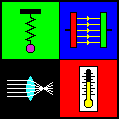|
This Java applet shows the interference of two circular respectively spherical waves (e.g. of water or sound waves). The waves spread out from two sources oscillating with the same phase. For the interference of the waves the principle is valid that the elongations are added, considering their signs.
You can observe the following two extreme cases:
At those points, where the difference Ds of the path lengths (the difference of the distances from the two sources) is an integer multiple of the wavelength l, the waves arrive with the same phase: This means that maxima (black circles) respectively minima (gray circles) always arrive at the same time, so that the interference is constructive (maximal amplitude). Points with this property are situated on the red marked curves respectively surfaces.
At those points, where the difference Ds of the path lengths is an odd half-integer multiple of the wavelength l, there are opposite conditions: At those points which are situated on the blue painted curves respectively surfaces a maximum of one wave always arrives simultaneously with a minimum of the other one, so that the resulting wave is diminished (destructive interference, minimal amplitude).
The button "Pause / Resume" of the applet makes it possible to stop or continue the simulation. If you choose the option "Slow motion", the animation will be five times slower. You can vary the distance of the two sources and the wavelength by using the corresponding text fields (Don't forget to press the "Enter" key!). At the bottom the program indicates the difference Ds of the path lengths (see above) for the violet coloured point. You can move this point with pressed mouse button.
![]()
 |
| Physics Applets (Overview) |
URL: http://home.a-city.de/walter.fendt/phe/interference.htm
© Walter Fendt, May 22, 1999
Last modification: December 20, 1999